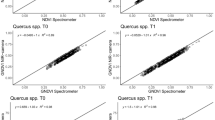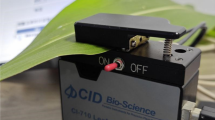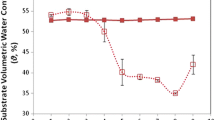Abstract
This study assessed the capability of several xanthophyll, chlorophyll and structure-sensitive spectral indices to detect water stress in a commercial farm consisting of five fruit tree crop species with contrasting phenology and canopy architecture. Plots irrigated and non-irrigated for eight days of each species were used to promote a range of plant water status. Multi-spectral and thermal images were acquired from an unmanned aerial system while concomitant measurements of stomatal conductance (gs), stem water potential (Ψs) and photosynthesis were taken. The Normalized Difference Vegetation Index (NDVI), red-edge ratio (R700/R670), Transformed Chlorophyll Absorption in Reflectance Index normalized by the Optimized Soil Adjusted Vegetation Index (TCARI/OSAVI), the Photochemical Reflectance Index using reflectance at 530 (PRI) and 515 nm [PRI(570–515)] and the normalized PRI (PRInorm) were obtained from the narrow-band multi-spectral images and the relationship with the in-field measurements explored. Results showed that within the Prunus species, Ψs yielded the best correlations with PRI and PRI(570–515) (r2 = 0.53) in almond trees, with TCARI/OSAVI (r2 = 0.88) in apricot trees and with PRInorm, R700/R670 and NDVI (r2 from 0.72 to 0.88) in peach trees. Weak or no correlations were found for the Citrus species due to the low level of water stress reached by the trees. Results from the sensitivity analysis pointed out the canopy temperature (Tc) and PRI(570–515) as the first and second most sensitive indicators to the imposed water conditions in all the crops with the exception of apricot trees, in which Ψs was the most sensitive indicator at midday. PRInorm was the least sensitive index among all the water stress indicators studied. When all the crops were analyzed together, PRI(570–515) and NDVI were the indices that better correlations yielded with Crop Water Stress Index, gs and, particularly, Ψs (r2 = 0.61 and 0.65, respectively). This work demonstrated the feasibility of using narrow-band multispectral-derived indices to retrieve water status for a variety of crop species with contrasting phenology and canopy architecture.




Similar content being viewed by others
Abbreviations
- gs :
-
Stomatal Conductance
- Ψs :
-
Stem Water Potential
- CWSI:
-
Crop Water Stress Index
- Tc :
-
Canopy Temperature
- UAS:
-
Unmanned Aerial System
- NDVI:
-
Normalized Difference Vegetation Index
- R700/R670 :
-
Red Edge Ratio (reflectance at 700 nm divided by the reflectance at 670 nm)
- TCARI:
-
Transformed Chlorophyll Absorption in Reflectance Index
- OSAVI:
-
Optimized Soil Adjusted Vegetation Index
- PRI:
-
Photochemical Reflectance Index (using reflectance at 530 and 570 nm)
- PRInorm :
-
Normalized Photochemical Reflectance Index
- PRI(570–515) :
-
Photochemical Reflectance Index (using reflectance at 515 and 570 nm)
References
Albert, R. S., & Thornber, J. P. (1977). Water stress effect on the content and organization of chlorophyll in mesophyll and bundle sheath chloroplast. Plant Physiology, 59, 351–353.
Anderson, K., & Gaston, K. (2013). Lightweight unmanned aerial vehicles will revolutionize spatial ecology. Frontiers in Ecology and the Environment, 11(3), 138–146.
Bellvert, J., Zarco-Tejada, T. J., Gonzalez-Dugo, V., Girona, J., & Fereres, E. (2013). Scheduling vineyard irrigation based on mapping leaf water potential from airborne thermal imagery. Precision Agriculture. doi:10.3920/978-90-8686-778-3_8.
Bendig, J., Bolten, A., & Bareth, G. (2012). Introducing a low-cost mini-UAV for thermal- and multispectral-imaging. The International Archives of the Photogrammetry, Remote Sensing and Spatial Information Sciences, 39(B1), 345–349.
Berni, J. A. J., Zarco-Tejada, P. J., Suárez, L., & Fereres, E. (2009). Thermal and narrowband multispectral remote sensing for vegetation monitoring from an unmanned aerial vehicle. IEEE Transactions on Geoscience and Remote Sensing, 47(3), 722–738.
Chaves, M. M., Pereira, J. S., Maroco, J., Rodrigues, M. L., Ricardo, C. P. P., Osorio, M. L., et al. (2002). How plants cope with water stress in the field. Photosynthesis and growth. Annals of Botany, 89, 907–916.
Field, C. B., Barros, V. R., Dokken, D. J., Mach, K. J., Mastrandrea, M. D., Bilir, T. E., et al. (2014). IPCC, 2014: Climate change 2014: Impacts, adaptation and vulnerability. Part A: Global and sectoral aspects. Contribution of working group II to the fifth assessment report of the intergovernmental panel on climate change. Cambridge University Press, Cambridge, United Kingdom and New York, NY, USA.
Gago, J., Douthe, C., Coopman, R. E., Gallego, P. P., Ribas-Carbo, M., Flexas, J., et al. (2015). UAVs challenge to assess water stress for sustainable agriculture. Agricultural Water Management, 153, 9–19.
Gamon, J. A., Peñuelas, J., & Field, C. B. (1992). A narrow-waveband spectral index that tracks diurnal changes in photosynthetic efficiency. Remote Sensing of Environment, 41, 35–44.
Goldhamer, D. A., & Fereres, E. (2001). Irrigation scheduling protocols using continuously recorded trunk diameter measurements. Irrigation Science, 20, 115–125.
Goldhamer, D. A., Fereres, E., Mata, M., Girona, J., & Cohen, M. (1999). Sensitivity of continuous and discrete plant and soil water status monitoring in peach trees subjected to deficit irrigation. Journal of the American Society for Horticultural Science, 124(4), 437–444.
Gonzalez-Dugo, V., Zarco-Tejada, P. J., Berni, J. A. J., Suárez, L., Goldhamer, D. A., & Fereres, E. (2012). Almond tree canopy temperature reveals intra-crown variability that is water-stress dependent. Agricultural and Forest Meteorology, 154–155, 156–165.
Gonzalez-Dugo, V., Zarco-Tejada, P. J., Nicolás, E., Nortes, P. A., Alarcón, J. J., Intrigliolo, D. S., et al. (2013). Using high resolution UAV thermal imagery to assess the variability in the water status of five fruit tree species within a commercial orchard. Precision Agriculture, 14(6), 660–678.
Haboudane, D., Miller, J. R., Tremblay, N., Zarco-Tejada, P. J., & Dextraze, L. (2002). Integration of hyperspectral vegetation indices for prediction of crop chlorophyll content for application to precision agriculture. Remote Sensing of Environment, 81(2–3), 416–426.
Hernández-Clemente, R., Navarro-Cerrillo, R., Suárez, L., Morales, F., & Zarco-Tejada, P. J. (2011). Assessing structural effects on PRI for stress detection in conifer forests. Remote Sensing of Environment, 115(9), 2360–2375.
Inskeep, W. P., & Bloom, P. R. (1985). Extinction coefficients of chlorophyll a and b in N, N-dimethylformamide and 80% acetone. Plant Physiology, 60, 606–608.
Intrigliolo, D. S., & Castel, J. R. (2006). Performance of various water stress indicators for prediction of fruit size response to deficit irrigation. Agricultural Water Management, 83, 173–180.
Moriana, A., & Fereres, E. (2002). Plant indicators for scheduling irrigation of young olive trees. Irrigation Science, 21, 83–90.
Mulla, D. (2013). Twenty five years of remote sensing in precision agriculture: Key advances and remaining knowledge gaps. Biosystems Engineering, 114, 358–371.
Peguero-Pina, J. J., Morales, F., Flexas, J., Gil-Pelegrin, E., & Moya, I. (2008). Photochemistry, remotely sensed physiological reXectance index and de-epoxidation state of the xanthophyll cycle in Quercus coccifera under intense drought. Oecologia, 156, 1–11.
Pérez-Sarmiento, F., Alcobendas, R., Mounzer, O., Alarcón, J., & Nicolás, E. (2010). Effects of regulated deficit irrigation on physiology and fruit quality in apricot trees. Spanish Journal of Agricultural Research, 8(S2), S86–S94.
Romero-Trigueros, C., Nortes, P. A., Alarcón, J. J., Hunink, J. E., Parra, M., Contreras, S., et al. (2016). Effects of saline reclaimed waters and deficit irrigation on Citrus physiology assessed by UAV remote sensing. Agricultural Water Management. doi:10.1016/j.agwat.2016.09.014.
Rouse, J. W., Haas, R. H., Schell, J. A., & Deering, D. W. (1974). Monitoring vegetation systems in the Great Plains with ERTS. In: S. C. Fraden, E. P. Marcanti & M. A. Becker (Eds.), Third ERTS-1 symposium. NASA SP-351 (pp. 309–317). Washington D.C., USA: NASA.
Suárez, L., Zarco-Tejada, P. J., González-Dugo, V., Berni, J. A. J., Sagardoy, R., & Morales, F. (2010). Detecting water stress effects on fruit quality in orchards with time-series PRI airborne imagery. Remote Sensing of Environment, 114, 286–298.
Suárez, L., Zarco-Tejada, P. J., Sepulcre-Canto, G., Perez-Priego, O., Miller, J. R., Jimenez-Muñoz, J. E., et al. (2008). Assessing canopy PRI for water stress detection with diurnal airborne imagery. Remote Sensing of Environment, 112, 560–575.
Taghvaeian, S., & Neale, C. M. U. (2011). Water balance of irrigated areas: A remote sensing approach. Hydrological Processes, 25, 4132–4141.
Zarco-Tejada, P. J., Gonzalez-Dugo, V., & Berni, J. A. J. (2012). Fluorescence, temperature and narrow-band indices acquired from a UAV platform for water stress detection using a micro-hyperspectral imager and a thermal camera. Remote Sensing of Environment, 117, 322–337.
Zarco-Tejada, P. J., Gonzalez-Dugo, V., Williams, L. E., Suárez, L., Berni, J. A. J., Goldhamer, D., et al. (2013). A PRI-based water stress index combining structural and chlorophyll effects: Assessment using diurnal narrow-band airborne imagery and the CWSI thermal index. Remote Sensing of Environment, 138, 38–50.
Zarco-Tejada, P. J., Miller, J. R., Morales, A., Berjón, A., & Agüera, J. (2004). Hyperspectral indices and model simulation for chlorophyll estimation in open-canopy tree crops. Remote Sensing of Environment, 90, 463–476.
Acknowledgements
Authors acknowledge K. Gutierrez, D. Notario, P.A Nortes, M.A. Jiménez-Bello and A. Vera for their technical support. This work was funded by the Spanish Ministry of Science and Innovation for the Projects CONSOLIDER CSD2006-0067, AGL2009-13105, AGL2010-17553 and AGL2013-49047-C2-2-R and the European Union through Projects Interreg SUDOE IVB “Telerieg”, IRRIQUAL (EU-FP6-FOOD-CT-2006-023120) and SIRRIMED (KBBE-2009-1-2-03, Proposal No. 245159). We are also grateful to two SENECA Projects (05665/PI/07 and 11872/PI/09) and SENECA—Excelencia Científica (19903/GERM/15), for providing funds to finance this research.
Author information
Authors and Affiliations
Corresponding author
Rights and permissions
About this article
Cite this article
Ballester, C., Zarco-Tejada, P.J., Nicolás, E. et al. Evaluating the performance of xanthophyll, chlorophyll and structure-sensitive spectral indices to detect water stress in five fruit tree species. Precision Agric 19, 178–193 (2018). https://doi.org/10.1007/s11119-017-9512-y
Published:
Issue Date:
DOI: https://doi.org/10.1007/s11119-017-9512-y




